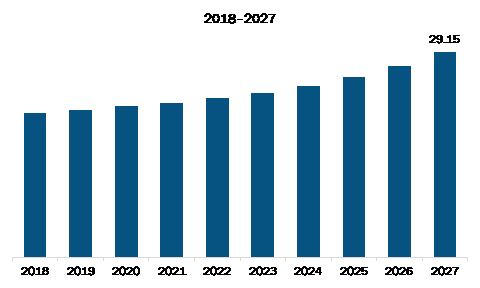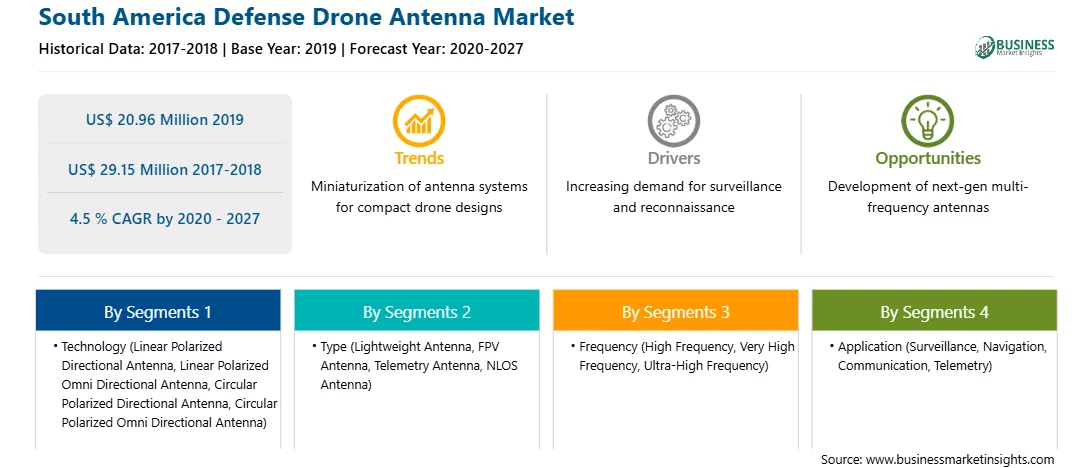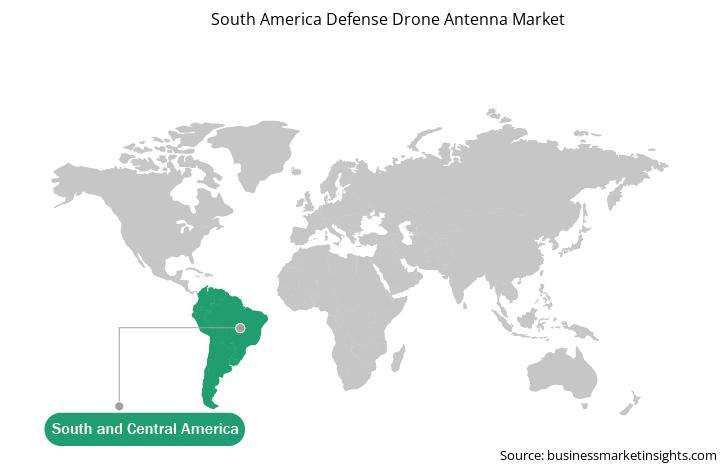Unmanned aerial vehicles (UAV) have been designed and developed for military and civilian applications. The UAV manufacturing sector for SAM region is in the growth phase of its life cycle. These vehicles are widely used for fighter combat, surveillance, aircraft carrier operations, stealth missions, and military communications applications. The drone technology is interdisciplinary with the integration of aerospace structures, telemetry, electronics, and other components. The production of UAVs requires a substantial number of electronic components for the data recording and transmission applications, and also for avionic functions. The antennas are among the most vital electronic components of any UAV, as these antennas enable the vehicle to transmit data to and receive data from other systems, as well as the people on the ground. The antennas which are utilized on unmanned vehicles are, in general, flexible, rugged dipole or blade antennas with the omnidirectional coverage. Thus, as UAVs' demand increases for SAM, the need for a broader range of antennas will also increase for data communications systems, payloads, command and control systems. The market players across SAM are offering a range of entry-level, standard cost-effective, high performance antenna designs that are already utilized on drones. Factors such as rising research and development to introduce newer variants in antennas and drone antennas continuous improvements are expected to drive the SAM defense drone antenna market. Furthermore, in case of COVID-19, the Brazil has the highest number of COVID-19 confirmed cases, followed by other countries such as Ecuador, Peru, Chile, and Argentina across SAM region. The government of SAM has taken an array of actions to protect their citizens and contain COVID-19’s spread. Brazil, Colombia, and Chile are the major countries in the region who set substantial budgets on defense and military sector. The coronavirus has hit hard on these three countries, and the defense forces in the countries mentioned above are considerably dependent on international defense equipment suppliers. The closure of international borders, restrictions in international trades, and governmental focus towards containing the spread of virus has been deprioritizing military expenditure. This factor is having a negative influence on defense drone antenna market across SAM region.

Strategic insights for the South America Defense Drone Antenna provides data-driven analysis of the industry landscape, including current trends, key players, and regional nuances. These insights offer actionable recommendations, enabling readers to differentiate themselves from competitors by identifying untapped segments or developing unique value propositions. Leveraging data analytics, these insights help industry players anticipate the market shifts, whether investors, manufacturers, or other stakeholders. A future-oriented perspective is essential, helping stakeholders anticipate market shifts and position themselves for long-term success in this dynamic region. Ultimately, effective strategic insights empower readers to make informed decisions that drive profitability and achieve their business objectives within the market.

| Report Attribute | Details |
|---|---|
| Market size in 2019 | US$ 20.96 Million |
| Market Size by 2027 | US$ 29.15 Million |
| Global CAGR (2020 - 2027) | 4.5 % |
| Historical Data | 2017-2018 |
| Forecast period | 2020-2027 |
| Segments Covered |
By Technology
|
| Regions and Countries Covered | South and Central America
|
| Market leaders and key company profiles |
The geographic scope of the South America Defense Drone Antenna refers to the specific areas in which a business operates and competes. Understanding local distinctions, such as diverse consumer preferences (e.g., demand for specific plug types or battery backup durations), varying economic conditions, and regulatory environments, is crucial for tailoring strategies to specific markets. Businesses can expand their reach by identifying underserved areas or adapting their offerings to meet local demands. A clear market focus allows for more effective resource allocation, targeted marketing campaigns, and better positioning against local competitors, ultimately driving growth in those targeted areas.

The SAM defense drone antenna market is expected to grow from US$ 20.96 million in 2019 to US$ 29.15 million by 2027; it is estimated to grow at a CAGR of 4.5 % from 2020 to 2027.Upsurge in drone procurement by military forces due to higher defense budgets is expected to accelerate the SAM defense drone antenna market. A rapidly changing modern warfare has been urging governments of various countries across SAM to allocate higher amounts toward the respective military forces. The military budget allocation enables the military forces to procure advanced technologies and equipment from national or international manufacturers. On the same lines, solider and military vehicle modernization practices are also on rise in many SAM countries. The procurement of drones or unmanned aerial vehicles (UAVs) is a major part of this modernization strategy. In addition, the defense ministries across SAM are investing substantial amounts in newer technologies, including contemporary UAVs or unmanned aircraft systems (UAS). The asymmetric warfare or modern battlefields demand enormous information to carry out the operations successfully. To gather such information related to the enemy, defense forces in the developed countries and developing nations across SAM are utilizing UAVs. Surge in orders for the drones or UAVs or UASs due to their advantages such as less risk, more accuracy, time saving etc. is expected to increase the demand of defense drone antenna which will drive the SAM defense drone antenna market.
In terms of technology, the linear polarized omni directional antenna segment accounted for the largest share of the SAM defense drone antenna market in 2019. In terms of type, the lightweight antenna segment held a larger market share of the SAM defense drone antenna market in 2019. Similarly, in terms of frequency, the ultra-high frequency segment held a larger market share of the SAM defense drone antenna market in 2019. Further, the communication segment held a larger share of the market based on application in 2019.
A few major primary and secondary sources referred to for preparing this report on SAM defense drone antenna market are company websites, annual reports, financial reports, national government documents, and statistical database, among others. Major companies listed in the report are Alaris Holdings Limited; Antcom Corporation; MP Antenna, LTD; TE Connectivity; Trimble Inc.
The List of Companies - South America Defense Drone Antenna Market
The South America Defense Drone Antenna Market is valued at US$ 20.96 Million in 2019, it is projected to reach US$ 29.15 Million by 2027.
As per our report South America Defense Drone Antenna Market, the market size is valued at US$ 20.96 Million in 2019, projecting it to reach US$ 29.15 Million by 2027. This translates to a CAGR of approximately 4.5 % during the forecast period.
The South America Defense Drone Antenna Market report typically cover these key segments-
The historic period, base year, and forecast period can vary slightly depending on the specific market research report. However, for the South America Defense Drone Antenna Market report:
The South America Defense Drone Antenna Market is populated by several key players, each contributing to its growth and innovation. Some of the major players include:
The South America Defense Drone Antenna Market report is valuable for diverse stakeholders, including:
Essentially, anyone involved in or considering involvement in the South America Defense Drone Antenna Market value chain can benefit from the information contained in a comprehensive market report.